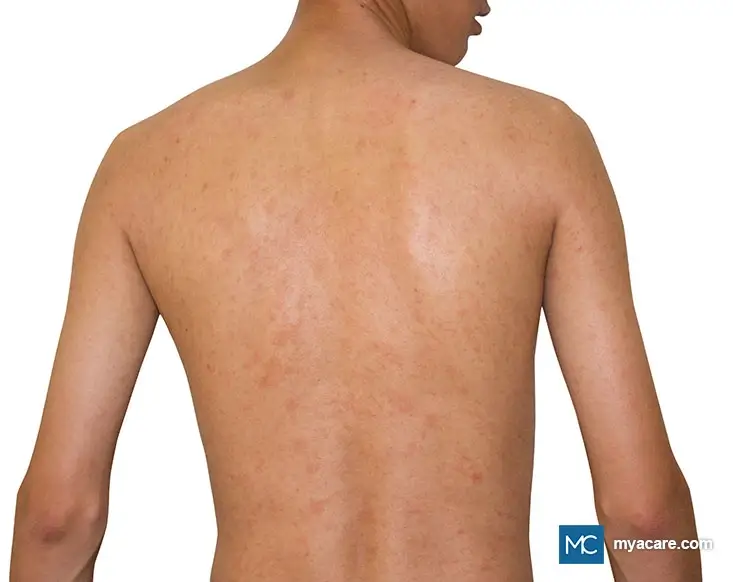Pityriasis Rosea

What is Pityriasis Rosea?
Pityriasis rosea (PR) is a common self-limiting skin rash that usually lasts for about 5-10 weeks. It affects the chest, abdomen, and back. It has the tendency to go away on its own, and is non-contagious. However, the rash can affect large parts of the body, which is commonly a cause for concern for patients.
What is the Cause of Pityriasis Rosea?
The exact etiology of Pityriasis rosea is unknown, however, it is thought to be related to herpesvirus (HHV) 6 and/or 7. Many drugs are also associated with PR, such as non-steroidal anti-inflammatory drugs, hydrochlorothiazide, metronidazole, angiotensin-converting enzyme inhibitors, and many others. It is also hypothesized that PR can be triggered by vaccines such as the Bacillus Calmette-Guerin (BCG) vaccine, H1N1, smallpox, pneumococcus, and COVID-19 vaccines. However, generally speaking, the etiology of PR is still poorly understood.
Who Can Get Pityriasis Rosea?
Pityriasis rosea occurs in all races and age groups and has a worldwide distribution. It has an incidence of 0.64 per 100 dermatologic patients. It is most common in teenagers and young adults (ages 10 to 35 years), and occurs slightly more often in women compared to men.
What are the Signs and Symptoms?
The classic presentation of pityriasis rosea starts with the presence of a solitary large, round, pink, rose-colored, or erythematous lesion on the trunk, called a “herald patch” or a “mother patch.” This patch has a slightly depressed center, and a fine collarette of scales on the periphery. Herald patches are usually seen on the trunk, but can also be seen on the extremities or the neck.
Around two weeks after the appearance of the herald patch, an eruption of multiple, smaller pinkish to reddish lesions can appear on the trunk and extremities. These lesions are smaller versions of the herald patch, also with a round to oval appearance and a collarette of scales at the periphery. Classically, these lesions are aligned parallel to the lines of cleavage on the upper chest and back, giving a “Christmas tree” pattern distribution.
Patients who develop pityriasis rosea can also experience sore throat or flu-like symptoms prior to the appearance of rashes. Some may develop fever, headache, loss of appetite, nausea, fatigue, and body weakness.

How is Pityriasis Rosea Diagnosed?
The diagnosis of pityriasis rosea is straightforward, and is largely based on clinical history and physical examination. A blood test or skin punch biopsy is not recommended.
In 2003, a criteria was proposed for the diagnosis of pityriasis rosea. To fulfill the criteria, a patient must have 3 essential features and at least 1 of the optional features. They also included 3 exclusion features.
Essential features
- Discrete circular or oval lesions
- Scaling on most lesions
- Peripheral collarette scaling with central clearance on at least 2 lesions
Optional features
- Truncal and proximal limb distribution (<10% of lesions distal to mid-upper-arm and mid-thigh)
- Most lesions along skin cleavage lines
- Herald patch ≥ 2 days before other lesions
Exclusion features
- Multiple small vesicles at the center of ≥ 2 lesions
- ≥ 2 lesions on palmar or plantar skin surfaces
Treatment and Management
Pityriasis rosea is a self-limiting disease; therefore, patients would only necessitate supportive treatment. Most cases would require oral antihistamines for the itch, as well as topical corticosteroids for the rash. Light treatments using UVB light has also been shown to have some benefit. For severe cases of pityriasis rosea, acyclovir may be given.
Self- care
- Avoid constant sun exposure.
- Shower using a mild soap.
- Use moisturizing lotions and creams.
- Wear loose-fitting clothes.
- Apply a gentle sunscreen.
Complications and Prognosis
Pityriasis rosea is harmless. It resolves in around 6-10 weeks, and can leave post-inflammatory hypo- or hyperpigmentation. Recurrences are rare, but can still happen. There are no significant complications, however, some reports have stated an increased risk for premature delivery or fetal complications in pregnant women who develop pityriasis rosea. Women affected by pityriasis rosea should be followed carefully and co-managed with their OB-GYN, especially during the first 15 weeks of their pregnancy.
Some patients experience anxiety, depression, and an overall decrease in quality of life. It is important to reassure these patients that pityriasis rosea is self-limiting and has no long-term complications, especially in healthy individuals
To search for the best health providers for dermatology in Croatia, Germany, Greece, Italy, Malaysia, Singapore, Slovakia Spain, Thailand, The UAE, the UK, and the US, please use our free search engine.
To search for the best healthcare providers worldwide, please use the Mya Care search engine.
Dr. Lauren Livelo is a board-certified dermatologist from the Philippines. She has a degree in Medicine from the University of the East Ramon Magsaysay Memorial Medical Center, and has completed her dermatology residency training in the Research Institute for Tropical Medicine. Aside from her private practice, she enjoys writing about skin care and diseases of the skin.
References:
Featured Blogs



